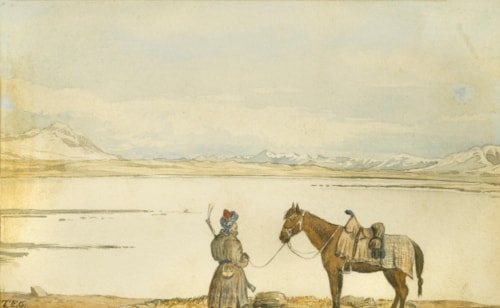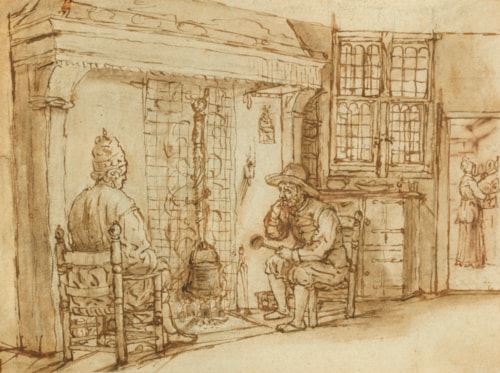hilipe-Jacques de Loutherbourg, R.A.
(Strasbourg 1740 - Chiswick 1812)
Smugglers on the English Coast
pen and brown ink, brown and grey wash, oval
22.8 x 31.7 cm (9 x 12½ in)
Engraved: Victor-Marie Picot, January 1776.
In this drawing Philippe-Jacques de Loutherbourg depicts a clandestine meeting of smugglers on the English coast. The drawing centres on two men who argue quite heatedly, presumably in relation to the quality or quantity of the smuggled goods, over which they stand. A figure is on his knees taking a closer look at the goods, whilst two men watch the argument play out. One smuggler is exhausted from the voyage and is slumped on the ground, his sword a reminder of the dangerous and dark side of these activities. A group of men are waiting in a rowing boat, and in the background is the faint outline of a much larger ship, although whether this is the smugglers’ or a customs’ ship, that they have outwitted, is uncertain.
Smuggling was a major business in Britain during the eighteenth century. Illegal trade across Britain’s coastline grew at an incredible rate as an inevitable result of the heavy taxation imposed by a series of governments seeking funds to pay for costly European wars; the tax for tea alone was nearly seventy percent of its initial cost by the middle of the century. In response to this, contraband was smuggled into the southern counties of England in huge quantities. It was not unheard of for a smuggling trip to bring in three thousand gallons of spirits. Illegally imported gin was sometimes so plentiful that the inhabitants of some Kentish villages were said to use it for cleaning their window. Some estimates reckon that four-fifths of tea drunk in England had not paid duty. So widespread was the practice that Daniel Defoe wrote of the port of Lymington ‘I do not find they have any foreign commerce, except it be what we call smuggling and roguing; which I may say, is the reigning commerce of all this part of the English coast, from the mouth of the Thames to the Land’s End in Cornwall’.¹
De Loutherbourg seems to have been fascinated by this lawless life and he depicted smugglers on several occasions, as well as bandits in a manner recalling Salvator Rosa (1615-1673). The Smugglers Return (Joslyn Art Museum, Nebraska) is one such example, and depicts a group of figures struggling to push their boat onto the shore, amid the stormy weather and crashing seas. The painting accentuates the perils associated with the business of smuggling, as these figures had to contend with the unpredictable forces of nature in order to accomplish their mission.
The subject matter of Smugglers on the English Coast was not an unusual one for artists, such was the prevalence of this business in the eighteenth century. For example George Morland’s The Smugglers also shows contraband being unloaded onto the English coast, the wagon ready be filled with the barrels which they are unloading. Although the scene does not take place at a legal port, the figures do not seem especially furtive or isolated. It is broad daylight and several other vessels can be seen in the background.
Smugglers on the English Coast was engraved in aquatint by de Loutherbourg and published by Victor-Marie Picot in January 1776. The aquatint was dedicated to the actor and theatre manager David Garrick, who employed de Loutherbourg as a stage designer in his Drury Lane Theatre, although it is unclear why de Loutherbourg chose this particular topic as a tribute to his friend.
¹ Daniel Defoe, A Tour Thro’ the Whole Island of Great Britain, Letter III, London, 1724
Engraved: Victor-Marie Picot, January 1776.
In this drawing Philippe-Jacques de Loutherbourg depicts a clandestine meeting of smugglers on the English coast. The drawing centres on two men who argue quite heatedly, presumably in relation to the quality or quantity of the smuggled goods, over which they stand. A figure is on his knees taking a closer look at the goods, whilst two men watch the argument play out. One smuggler is exhausted from the voyage and is slumped on the ground, his sword a reminder of the dangerous and dark side of these activities. A group of men are waiting in a rowing boat, and in the background is the faint outline of a much larger ship, although whether this is the smugglers’ or a customs’ ship, that they have outwitted, is uncertain.
Smuggling was a major business in Britain during the eighteenth century. Illegal trade across Britain’s coastline grew at an incredible rate as an inevitable result of the heavy taxation imposed by a series of governments seeking funds to pay for costly European wars; the tax for tea alone was nearly seventy percent of its initial cost by the middle of the century. In response to this, contraband was smuggled into the southern counties of England in huge quantities. It was not unheard of for a smuggling trip to bring in three thousand gallons of spirits. Illegally imported gin was sometimes so plentiful that the inhabitants of some Kentish villages were said to use it for cleaning their window. Some estimates reckon that four-fifths of tea drunk in England had not paid duty. So widespread was the practice that Daniel Defoe wrote of the port of Lymington ‘I do not find they have any foreign commerce, except it be what we call smuggling and roguing; which I may say, is the reigning commerce of all this part of the English coast, from the mouth of the Thames to the Land’s End in Cornwall’.¹
De Loutherbourg seems to have been fascinated by this lawless life and he depicted smugglers on several occasions, as well as bandits in a manner recalling Salvator Rosa (1615-1673). The Smugglers Return (Joslyn Art Museum, Nebraska) is one such example, and depicts a group of figures struggling to push their boat onto the shore, amid the stormy weather and crashing seas. The painting accentuates the perils associated with the business of smuggling, as these figures had to contend with the unpredictable forces of nature in order to accomplish their mission.
The subject matter of Smugglers on the English Coast was not an unusual one for artists, such was the prevalence of this business in the eighteenth century. For example George Morland’s The Smugglers also shows contraband being unloaded onto the English coast, the wagon ready be filled with the barrels which they are unloading. Although the scene does not take place at a legal port, the figures do not seem especially furtive or isolated. It is broad daylight and several other vessels can be seen in the background.
Smugglers on the English Coast was engraved in aquatint by de Loutherbourg and published by Victor-Marie Picot in January 1776. The aquatint was dedicated to the actor and theatre manager David Garrick, who employed de Loutherbourg as a stage designer in his Drury Lane Theatre, although it is unclear why de Loutherbourg chose this particular topic as a tribute to his friend.
¹ Daniel Defoe, A Tour Thro’ the Whole Island of Great Britain, Letter III, London, 1724





 contact
contact contact
contact +44 20 7313 8040
+44 20 7313 8040









